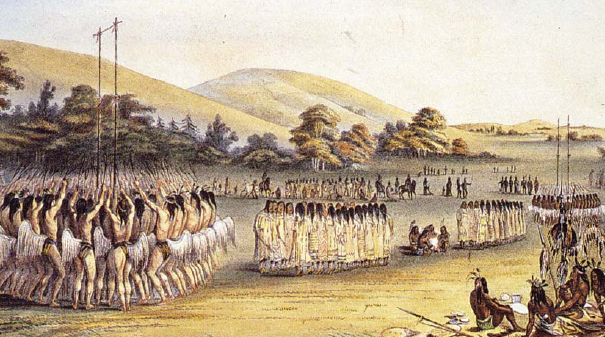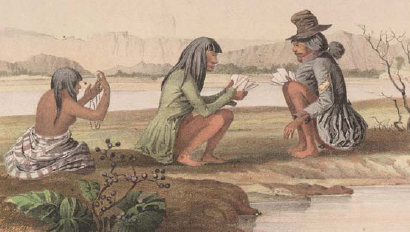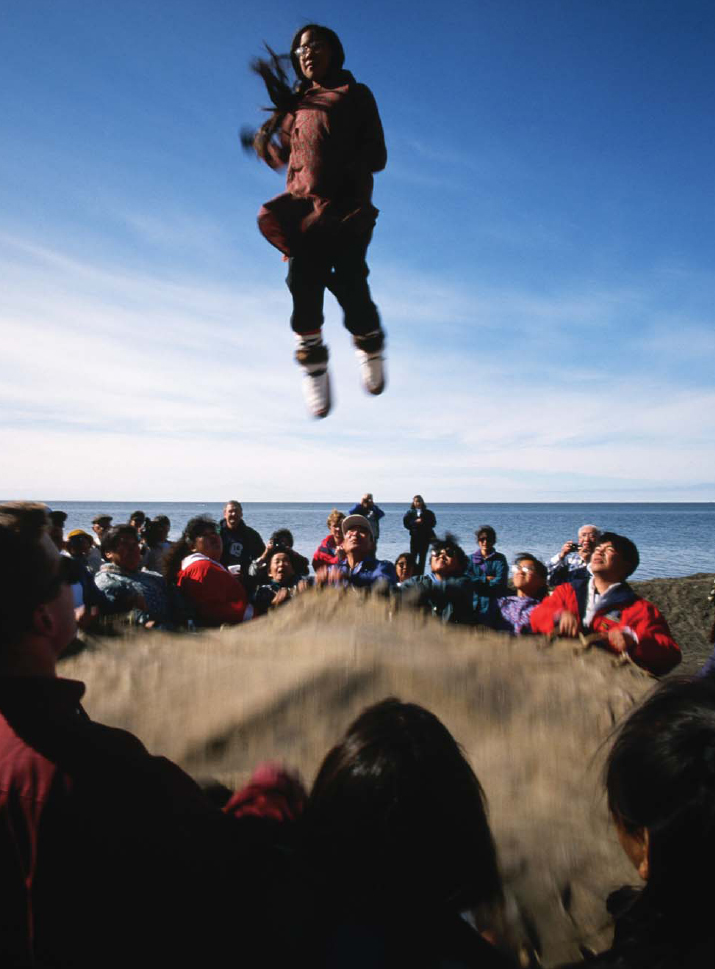
Two Native American ball teams gather around their goalposts while their women form lines for a ceremonial pregame dance.
Few tribes played snow snake in the South. The climate was too warm for much snow. Many southeastern tribes, however, played lacrosse: Cherokee, Choctaw, Muskogee, and Seminole people all enjoyed the game. Like their northern neighbors, they took it quite seriously. The Cherokee considered games “the little brother of war.” Nowhere was this attitude truer than in lacrosse.
Lacrosse was played from summer through the fall. Southeastern games involved even more ceremony than did those in the Northeast. Bands and villages would often challenge each other. Before their game, each competing village would hold a big dance ceremony. Men and women both danced, but they didn’t touch. Instead, the players held their rackets. After the dance, players went to the river for a cleansing ritual. It was important to keep the exact part of the river they went to secret. Otherwise, the other team could put a curse on them by scattering their path with small pieces of rabbit.
Rabbits were considered taboo before a game, because they are easily frightened and confused. Players could not eat rabbit meat for at least a week, and sometimes a month, before a game. Several other things were also prohibited. Players couldn’t eat frog, because frogs’ bones are brittle. Babies are also fragile, so they had to be avoided, too. During that same time period, players could not touch a woman. This rule lasted for a week after the game as well. Needless to say, women were not allowed to touch the rackets.

Two Native American ball teams gather around their goalposts while their women form lines for a ceremonial pregame dance.
The Natchez people in Louisiana played a game similar to modern horseshoes or lawn bowling. They called it the game of the pole. Two players would play. Each one carried a pole, about eight feet long. One would roll a ball onto the playing field. The ball was their target. Each player would throw his pole at the ball. Whoever got closest scored a point and rolled the ball for the next round.
Many other tribes of the Southeast played a similar game called chunkey. The best description of chunkey comes from the Mandan people of Missouri. Their games of chunkey were similar to the hoop and pole games of the North. In their case, they rolled a small stone ring, about three inches wide. The ring would still be moving when the players threw their poles. A perfect throw meant that the ring stopped around the tip of a pole. They played on a smooth, clay court, so the pole would have a chance to slide. Still, this was an extremely difficult shot.
A Cherokee man whose wife was pregnant was not allowed to play lacrosse. His strength was believed to be with his child.
The artist George Catlin observed many games of Mandan chunkey. He wrote, “It is a game of great beauty, and fine bodily exercise, and these people have become excessively fascinated with it.” This was true, to a horrible degree. Many chunkey players gambled themselves into poverty. Catlin reported that some players would “stake their liberty upon the issue of these games, offering themselves as slaves to their opponents in case they got beaten.” Every so often, a player, devastated after a big loss, would even take his own life.
Another popular Mandan game was called the game of the arrow. This game also drew wagers, although not to the extremes of chunkey. Every player would put up a shield, a blanket, or some other valuable item as an entry fee. The winner would get everything at the end of the game. Unlike most archery competitions, accuracy was not important. In the game of the arrow, only speed counted. Archers would compete one at a time. The archer would fire an arrow into the air. Immediately, he would fire a second and a third. The object was to get the most arrows into the air before the first one hit the ground. The fastest archers could get as many as eight arrows into the air at once.

Native Americans frequently gambled—on games of chance between two players or on the outcome of team competitions.
Not all of the games in the region were strenuous physical contests. Choctaw women played a lighthearted game that resembled jacks. The player would throw a ball into the air. She had to pick up a stick in time to catch the ball before it hit the ground. A player would continue until she had picked up all the playing sticks or missed catching the ball.
Choctaw men also enjoyed a dice game. Their dice were not like the ones made today. They used eight kernels of white corn as dice. One side of each kernel was charred black. This way, each die had two sides. The men would throw the dice and gain one point for each light side showing. All eight black sides up would count for eight points. The men bet on who would win the most points.
Another popular game was the ring and pin game. In a sense, it was a tiny, solitary game of chunkey. The equipment was a ring, or target, with a hole in it. Often, it was made from a bone, or several bones. It would be attached to a pin with a thin cord. Like chunkey, the object was to spear the ring with the pin. The player would throw the target into the air. As the target fell, he would try to catch it on the pin. Sometimes the target had several holes, each worth a different point value.
Long ago, the four-legged animals challenged the birds to a lacrosse game. The animals had a good team. The fast deer, the strong bear, and the tough turtle were all ready to play. Some smaller animals also wanted to play, but the big ones wouldn’t let them. So, two small mammals asked to play on the birds’ team.
The birds would let them, but they needed to be able to fly. They made one of the animals a set of wings from drum leather. This is how the bat was born. Unfortunately, the birds didn’t have enough leather for the other creature. Instead, they took his skin and stretched it out over his arms and legs. He became a flying squirrel.
Soon, the game began. The flying squirrel swooped down and grabbed the ball first. He scampered up a tree and gave the ball to the birds. The birds kept the ball in the air for a long while, but couldn’t score. Eventually, one dropped the ball. The bat darted to the ground and caught the ball. He flew too fast for anyone, even the deer. He flew right to the goal and scored. Since then, bats and flying squirrels have been good luck for lacrosse players.
The Cheyenne called this a “love game.” It was often used as a way of introducing young men and women. To strike up a conversation, single men would ask women if they would like to play. If a woman accepted, they could begin a courtship.
Ring and pin games were played across the continent, and the rules were similar. Most of the variation was due to the materials at hand or the number of holes in the target. §

The blanket toss, a traditional game of the Inuit people, resembles gymnastics on a trampoline.